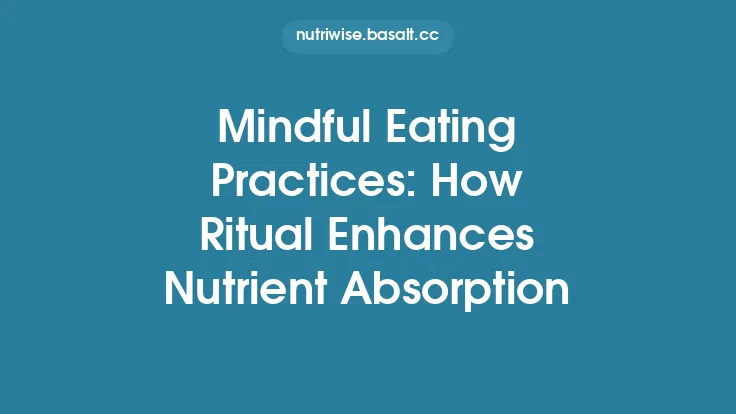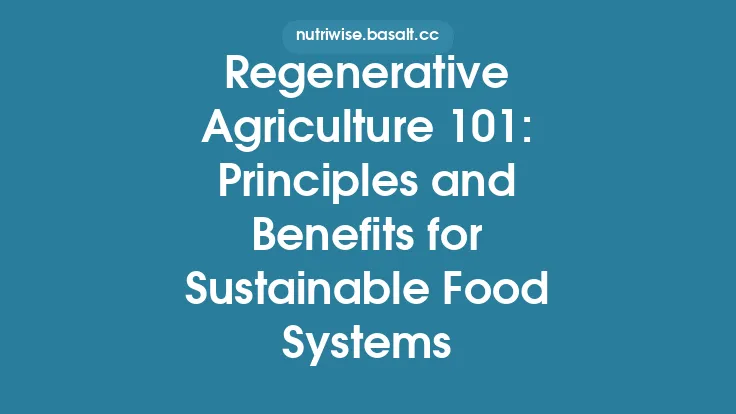Mindful eating is more than a buzzword; it is a purposeful approach to how we relate to food, our bodies, and each other at the dinner table. When families adopt mindful eating practices, meals become opportunities for connection, self‑awareness, and lasting health benefits. This article explores the foundational concepts, practical strategies, and scientific underpinnings that help families foster positive food relationships through mindful eating—without delving into the mechanics of meal planning, pantry stocking, or specific recipe construction.
Understanding Mindful Eating: Core Principles
At its heart, mindful eating draws from the broader practice of mindfulness: paying non‑judgmental, present‑moment attention to experience. Applied to food, the practice involves four interrelated pillars:
- Awareness of Sensory Experience – noticing taste, texture, aroma, and visual appeal.
- Recognition of Internal Cues – tuning into hunger, fullness, and satiety signals.
- Emotional Insight – observing feelings that arise before, during, and after eating.
- Intentional Choice – making food decisions that align with personal values and health goals.
These pillars are not isolated steps but a continuous feedback loop. When a family member feels a pang of anxiety, for instance, mindful eating invites them to pause, label the emotion, and decide whether to eat for nourishment or for comfort.
The Science Behind Mindful Eating and Family Health
Research across nutrition, psychology, and neuroscience demonstrates that mindful eating can:
- Modulate appetite hormones such as ghrelin and leptin, leading to more accurate hunger signaling.
- Reduce activation of the brain’s reward circuitry associated with impulsive, high‑sugar foods, thereby decreasing overeating.
- Enhance gut‑brain communication, improving digestion and reducing gastrointestinal discomfort.
- Lower stress‑related cortisol spikes, which are linked to abdominal fat accumulation and metabolic dysregulation.
In children, early exposure to mindful eating practices correlates with healthier body composition trajectories and a reduced risk of developing disordered eating patterns later in life.
Creating a Mindful Eating Environment at Home
The physical and social setting of a meal can either support or sabotage mindfulness. Consider these environmental tweaks:
| Element | Mindful‑Friendly Adjustment |
|---|---|
| Lighting | Use warm, dimmable lights to create a calm ambiance, avoiding harsh fluorescents that signal urgency. |
| Noise | Minimize background television or music during meals; allow natural conversation to flow. |
| Seating | Encourage upright, comfortable seating that promotes alertness without strain. |
| Table Layout | Place dishes centrally, allowing each person to see the full spread, which invites curiosity and slows the pace of eating. |
| Device Policy | Institute a “no‑screen” rule for at least 20 minutes before and after the meal to preserve focus. |
These subtle changes signal to family members that the meal is a dedicated time for presence and connection.
Engaging All Ages: Age‑Appropriate Mindful Practices
Toddlers (1‑3 years)
- Offer bite‑size portions and pause between spoonfuls, allowing the child to explore texture with their hands.
- Use simple language: “Notice how the carrot feels crunchy.”
Elementary Children (4‑10 years)
- Introduce a “taste‑check” game: identify sweet, salty, sour, and bitter notes.
- Encourage a “hunger‑fullness scale” from 1 (very hungry) to 10 (completely satisfied) before and after meals.
Adolescents (11‑18 years)
- Invite them to keep a brief mindful eating journal, noting emotions, hunger levels, and sensory observations.
- Discuss the impact of stress on cravings, fostering self‑regulation skills.
Adults
- Practice “mindful breathing” for 30 seconds before the first bite to center attention.
- Use a “pause button”—a gentle hand on the table—to remind themselves to check in with internal cues.
Modeling Mindful Behaviors: The Role of Parents and Caregivers
Children learn primarily through observation. When caregivers consistently demonstrate mindful eating, they set a powerful template:
- Eat slowly: Aim for 20–30 chews per bite, which naturally extends meal duration and improves satiety signaling.
- Verbalize sensations: “I love how the apple is crisp and sweet.”
- Acknowledge cravings without judgment: “I’m feeling a strong desire for chips, but I’ll choose a handful of carrots instead.”
- Practice gratitude: Briefly reflect on the source of the food—farm, farmer, or family effort—before the first bite.
These actions reinforce that mindful eating is a valued, everyday practice rather than an occasional novelty.
Incorporating Sensory Exploration into Meals
Sensory engagement deepens mindfulness and can transform routine meals into learning experiences:
- Sight: Arrange colors deliberately—red tomatoes, orange carrots, green peas—to stimulate visual interest.
- Smell: Allow a brief “aroma pause” where each person inhales the steam and notes the fragrance.
- Touch: Encourage children to feel the texture of a cooked vegetable before tasting it.
- Taste: Use a “flavor wheel” to identify basic taste components, fostering a richer palate.
- Sound: Notice the crunch of fresh lettuce or the sizzle of a stir‑fry, adding an auditory dimension.
By rotating focus among the senses, families keep attention anchored in the present moment.
Mindful Communication Around Food
Conversation at the table can either support mindfulness or distract from it. Adopt these communication guidelines:
- Stay present: Keep topics relevant to the meal experience—e.g., “What flavors stand out to you?”—instead of launching into unrelated news.
- Use “I” statements: Share personal experiences (“I felt energized after the salad”) rather than prescribing (“You should always eat salad”).
- Validate emotions: If a child expresses disappointment about a dish, acknowledge the feeling before suggesting alternatives.
- Encourage curiosity: Ask open‑ended questions like, “What would happen if we added a pinch of lemon?” to spark exploratory thinking.
Such dialogue nurtures a safe space for honest reflection about food.
Recognizing and Responding to Hunger and Fullness Cues
A cornerstone of mindful eating is the ability to differentiate physiological signals from external prompts. Teach families to:
- Check in pre‑meal – Rate hunger on a 0‑10 scale; aim to start eating when the rating is 3‑5.
- Pause mid‑meal – Every 5–7 minutes, place the utensil down, assess fullness, and decide whether to continue.
- Post‑meal reflection – Note the final fullness rating; if it exceeds 8, consider reducing portion size next time.
These self‑checks help prevent both under‑ and over‑eating, fostering a balanced internal regulation system.
Managing Emotional Eating Within the Family Context
Emotions often masquerade as hunger. To address this:
- Label the feeling: “I’m feeling stressed, not hungry.”
- Identify triggers: Keep a simple log of situations that precede emotional cravings (e.g., after a tough school day).
- Offer alternative coping tools: Deep breathing, a short walk, or a creative activity can satisfy the emotional need without food.
- Create a “comfort corner”: A designated space with non‑food comfort items (books, art supplies) signals that soothing is possible beyond eating.
When families collectively recognize and respect emotional cues, they reduce reliance on food as a primary coping mechanism.
Mindful Cooking as a Family Activity
Cooking itself is a fertile ground for mindfulness. Incorporate these practices:
- Pre‑cook intention setting: Before chopping, pause and state a purpose (“I’m preparing this soup to nourish my family”).
- Sensory focus while preparing: Feel the weight of a vegetable, listen to the sizzle, observe color changes.
- Collaborative timing: Assign each family member a specific, mindful task (e.g., washing greens while noting the water’s temperature).
- Reflection after cooking: Discuss what was enjoyable, challenging, or surprising during the process.
By treating cooking as a shared mindful ritual, families reinforce the connection between effort and nourishment.
Tools and Techniques for Practicing Mindful Eating Together
| Technique | How to Implement in a Family Setting |
|---|---|
| Belly Breathing | Take three slow breaths together before the first bite, focusing on the rise and fall of the abdomen. |
| Mindful Bite Count | Agree on a set number of chews per bite (e.g., 20) and use a silent hand signal to remind each other. |
| Gratitude Circle | Each person shares one thing they’re grateful for about the meal or the day. |
| Sensory Checklist | Pass a small card listing sight, smell, texture, taste, and sound; each member checks off items they notice. |
| Pause Bell | Use a gentle kitchen timer set for 10‑minute intervals to prompt a brief check‑in on hunger/fullness. |
These low‑tech tools are adaptable to any household and require minimal preparation.
Overcoming Common Barriers to Family Mindful Eating
- Time Pressure – Solution: Integrate micro‑mindful moments (e.g., a 30‑second breath before meals) rather than overhauling the entire schedule.
- Distracting Environments – Solution: Establish a “meal‑only” zone where devices are stored away; start with a few meals per week and gradually increase.
- Skepticism or Resistance – Solution: Frame mindfulness as a curiosity experiment rather than a mandate; invite family members to share observations without judgment.
- Inconsistent Hunger Signals – Solution: Encourage regular meal timing to help the body re‑establish reliable cues, while still honoring true hunger and fullness.
- Emotional Overload – Solution: Pair mindful eating with other stress‑reduction practices (e.g., family walks, shared storytelling) to address the root emotional drivers.
By anticipating these obstacles, families can devise realistic strategies that sustain mindful habits.
Measuring Success: Observing Shifts in Food Relationships
Quantitative metrics are less useful than qualitative changes. Look for:
- Increased conversation about flavors and textures rather than “how much” or “how fast.”
- Reduced frequency of “I’m not hungry” excuses when food is offered.
- More frequent self‑reports of feeling satisfied after meals without lingering cravings.
- Greater willingness to pause before reaching for snacks during non‑meal times.
- Improved emotional regulation, evident in fewer food‑related meltdowns or conflicts.
Documenting these observations in a family journal can reinforce progress and highlight areas needing attention.
Sustaining Mindful Eating Practices Over Time
Long‑term integration hinges on flexibility and reinforcement:
- Rotate mindful themes (e.g., “focus on aroma” one week, “gratitude” the next) to keep the practice fresh.
- Celebrate milestones—a month of consistent mindful meals could be marked with a family outing or a special, non‑food‑centric reward.
- Invite feedback: Periodically ask each member what they enjoy or find challenging, and adjust accordingly.
- Model lifelong learning: Parents can share articles, podcasts, or workshops they explore, demonstrating that mindfulness is an evolving journey.
- Embed mindfulness in other routines: Apply the same present‑moment awareness to bedtime stories, homework, or family games, reinforcing the skill set across contexts.
When mindful eating becomes woven into the fabric of daily family life, it transforms from a set of techniques into a shared value that nurtures both physical health and emotional well‑being.




